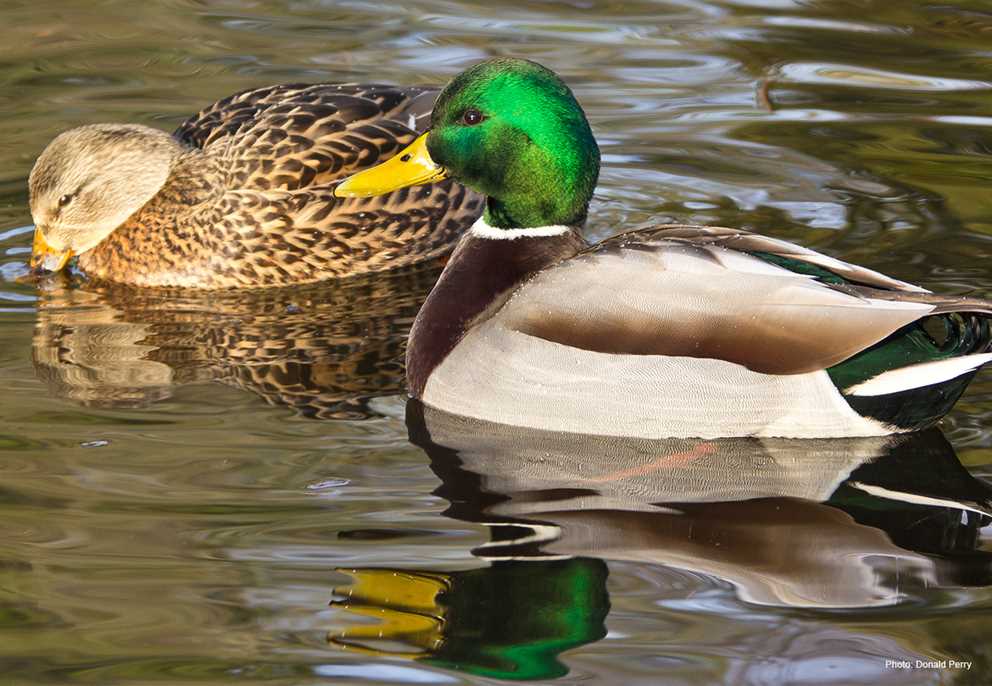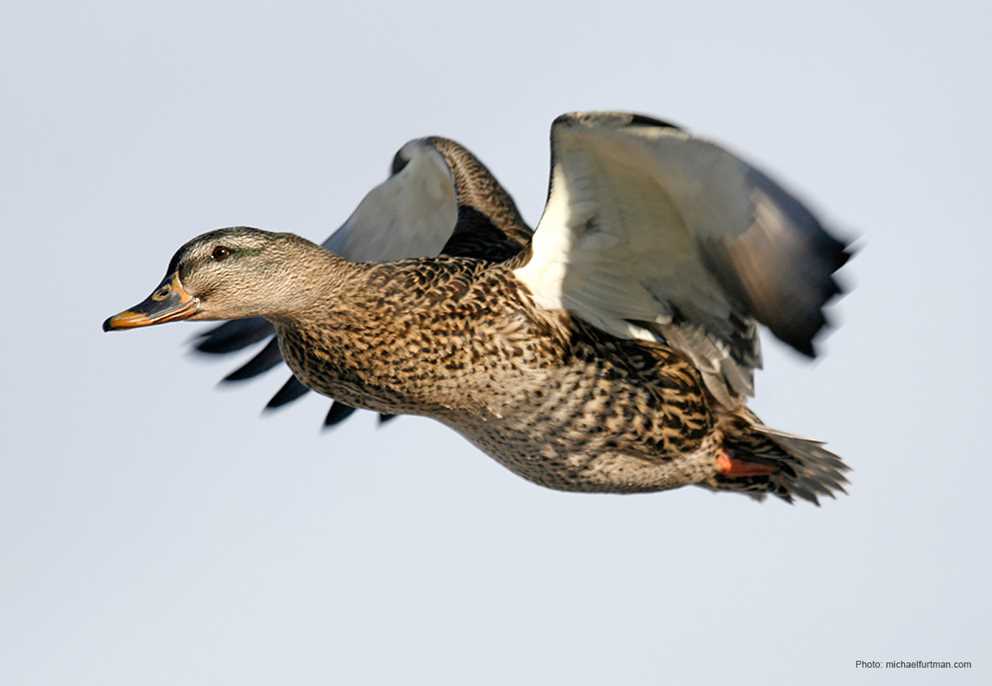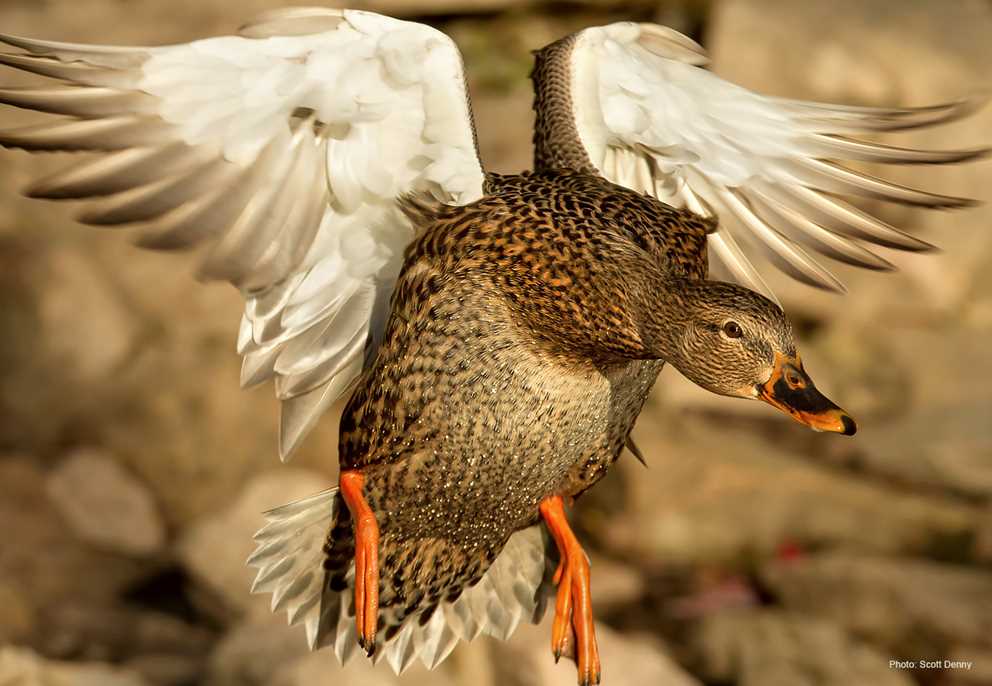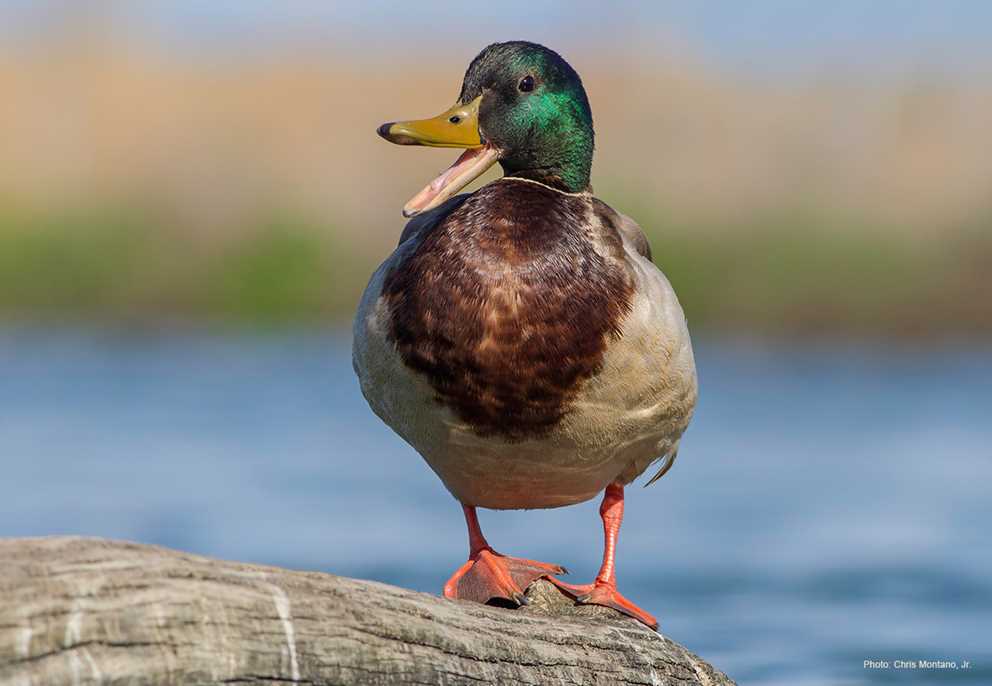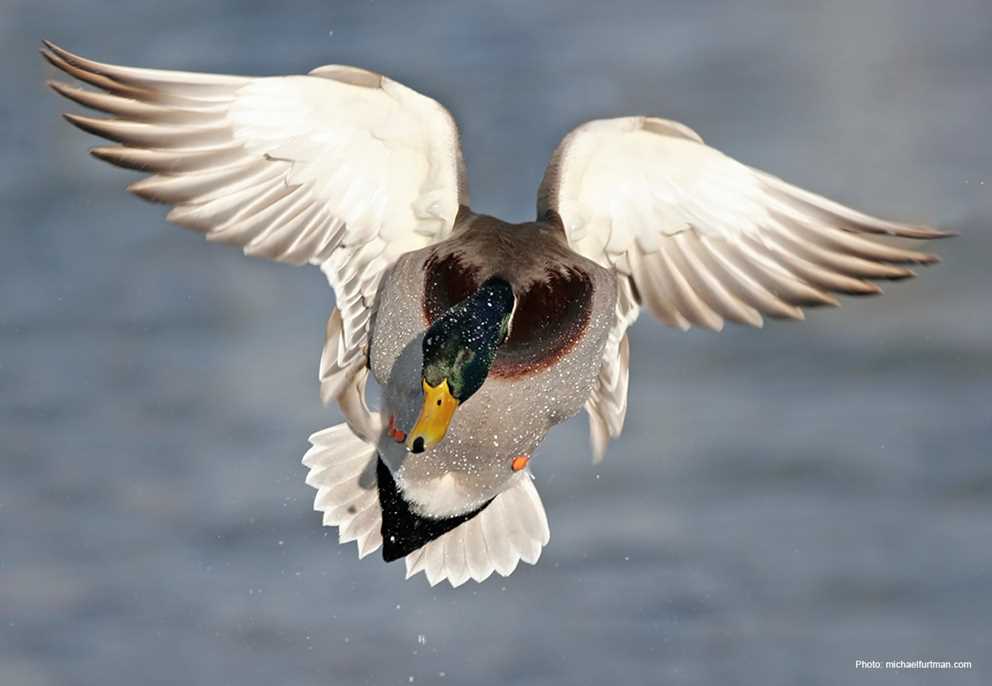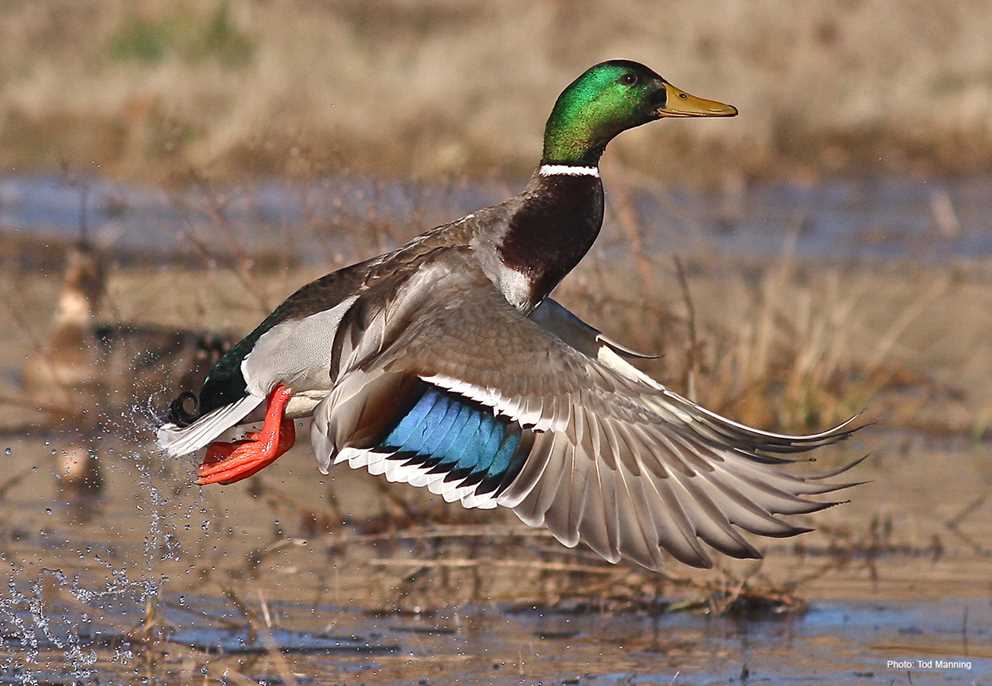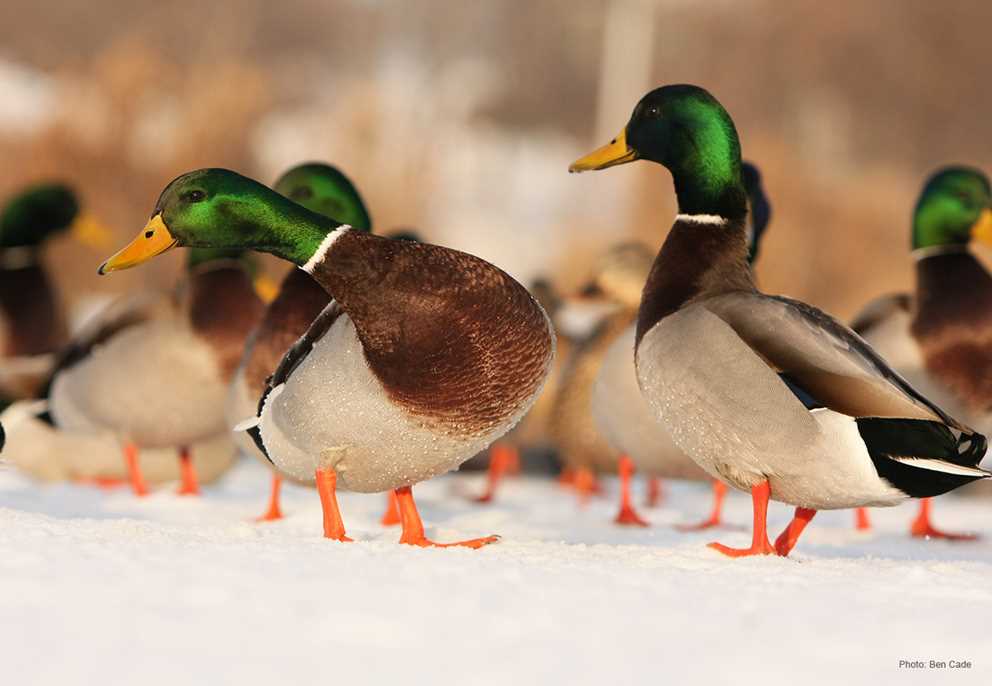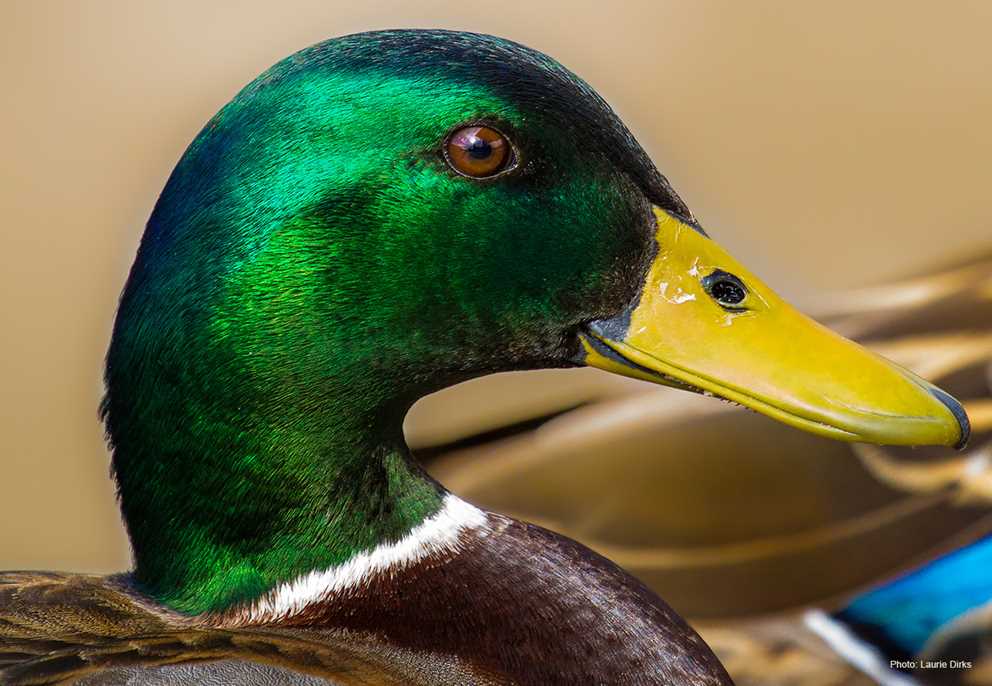Overview
The Mallard is a large dabbling duck that is the most abundant, widespread, most studied, and most recognized species of duck in the world. Its range includes most of Eurasia and North America. The success and resulting abundance of this species is due to their ability to adapt to varied habitats, tolerance of a wide range of temperatures, omnivorous diet, and tolerance of human disturbances.
Mallards nest in a variety of habitats including forests, prairies, farmlands, emergent wetlands, coastal wetlands, and urban areas. Mallards are omnivorous and eat a wide variety of plants and invertebrates.
Males in alternate plumage have a dark-green head, narrow white ring around the neck, a chestnut-brown breast, brownish-gray back, grayish belly, a black rump and undertail coverts, white outer tail feathers, and a recurved black central tail feather. In flight, the grayish wing has an iridescent blue speculum with upper and lower white margins, and white underwing coverts. The bill is yellow to olive, and the legs and feet are orange. Females in alternate plumage are mottled or streaky brown overall, the head has broken patterns of buff, white, gray, and brown with a notable dark brown eyestripe.
Description
Key Identification Features:
- Males in alternate plumage have a dark green iridescent head, narrow white ring around the neck, a chestnut-brown breast, brownish-gray back, grayish belly, a black rump and undertail coverts, white outer tail feathers, and a recurved black central tail feather. The bill is yellow to olive, and the legs and feet are orange.
- Females in alternate plumage are mottled or streaky brown overall, the head has broken patterns of buff, white, gray and brown with a notable dark-brown eyestripe. The bill is orange with variable black markings, and the legs and feet are orange.
Male/Female Average Length and Weight
- Mass: Males 2.6–2.8 lbs.; Females 2.3–2.5 lbs. .
- Wing Length: Males 11.2–11.5 in.; Females 10.6–10.9 in.
Male Identification:
- Alternate (Breeding) Plumage: Males in alternate plumage have a dark-green head, narrow white ring around the neck, a chestnut-brown breast, brownish-gray back, grayish belly, a black rump and undertail coverts, white outer tail feathers, and a recurved black central tail feather. The bill is yellow to olive.
- Basic Plumage: Overall mottled to streaky brown, sexes somewhat similar.
Female Identification:
- Alternate and Basic Plumage: Females in alternate plumage are mottled or streaky brown overall, the head has a broken pattern of buff, white, gray and brown with a notable dark-brown eyestripe. The bill is orange with variable black markings, and the legs and feet are orange.
In-Flight Identification:
- Male: In flight, the grayish wing has an iridescent blue speculum with upper and lower white margins, and white underwing coverts.
- Female: In flight, females show a brownish gray wing with the iridescent blue speculum similar to males, except the leading white edge extends further out onto the secondary coverts.
Vocalizations:
- Male Calls: make a very reedy “reab.”
- Female Calls: make a loud “quack” or a short series of decrescendo “quacks.”
Similar Species:
Identifications separating female Mallards from American Black Duck, Mottled Ducks and Mexican Ducks should be made cautiously because Mallards, especially feral populations existing within the range of these three species, readily hybridize with offspring which can make identification a challenge.
- Mottled Ducks: Female Mallards have superficial resemblance to Mottled Ducks, but Mottled Ducks are darker brown overall, with iridescent blue-green speculums that have much less to almost no white trailing edges, no contrasting pale belly, and a black spot at the gape and lack outer white tail feathers.
- American Black Ducks: Female Mallards also resemble American Black Ducks, but black ducks are much darker, have a purplish-blue to violet speculum with little to no trailing white edges, no pale belly feather contrasting with breast or sides, and no white outer tail feathers.
- Mexican Ducks: Both sexes of the Mexican Duck closely resemble female Mallards. Mexican ducks are slightly smaller overall and have distinctly darker coloration. They also have dark grayish-brown tails with no white outer rectrices, an iridescent greenish speculum with narrow white trailing edge only, and a more uniformly dark belly and undertail coverts.
Habitat Preferences
- Breeding: Mallards have adapted to use a diversity of wetland types across their breeding range. Mallards nest in forests, prairies, farmland, emergent wetlands, coastal wetlands, and urban areas.
- Wintering: Mallards are very tolerant of cold temperatures and winter often as far north as open water exists in any given winter.
Foraging Habits and Diet
- Breeding Season: Breeding Mallards, especially females, shift to a diet rich in invertebrates to support production of eggs.
- Migration and Winter: During the non-breeding season, Mallards eat a variety of seeds of wetland plants, and they have adapted to feed in upland agricultural fields on waste grains.
Breeding Habits
- Monogamy: Mallards are seasonally monogamous, usually forming pairs in wintering areas. Males leave with onset of incubation. The age at first breeding is one year.Mallards are early nesters, and while nest initiation dates vary with latitude, most initiate nests in March and April.
- Nest Locations: The nest is usually in upland areas, which may be forested, grassy, or in margins of agricultural fields. Some females will nest in dense emergent vegetation over water. Distance from nest to water is variable but may be up to one mile. Mallards will use artificial nest cylinders in some locations.
- Clutch Size: 6 to 11 eggs. The eggs are white to creamy white to pale green buff, elliptical to sub-elliptical or blunt oval and are 2.1–2.5 by 1.5–1.8in. The incubation period is around 28 days. They will readily renest if nest loss occurs during laying or early incubation.
Migration & Distribution
- Fall Migration: Mallards depart breeding areas in September or October depending on latitude. They arrive in winter areas from October through December. Mallards often winter as far north as open water exists and may move south during extended periods of ice and snow cover but return north if ice and snow melt during winter warm periods.
- Spring Migration: Migration begins in February through April with arrival on breeding areas in March or early April. A portion of the population across central North America may be considered resident as milder winters allow birds to remain year-round.
Conservation Status
- IUCN Status: Least Concern
- Population Status: The USFWS Waterfowl Population Status, 2024 estimate for the Eastern Survey Area was 1,169,000 but has been as high as 1.478 million and as low as 1.058 million since the survey started. The 2024 estimate for the USFWS WPHS for the Traditional Survey Area was 6.609 million birds but has ranged from 11.793 million (2016) to 4.961 million (1985).
- Conservation Concerns: Primary threat is loss of wetland and grassland habitats to conversion to agriculture and urbanization.
- Conservation Focus: Maintenance, restoration, and rehabilitation of wetland habitats including enhancing nesting cover, providing nesting structures, and synergistic agricultural land management.
Harvest Information
- An average of 2,570,420 Mallards were harvested per season across the US during the 2019 through 2022 hunting seasons.
- Mallard harvest is typically highest in the Mississippi Flyway accounting for 50 to 60 percent of the total US harvest.
- The top three harvest states for Mallards across the 2019–2022 hunting seasons were Arkansas (1,573,760), Washington (704,554), and Missouri (591,514).
